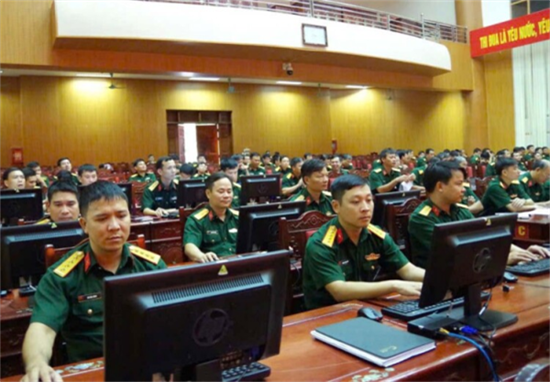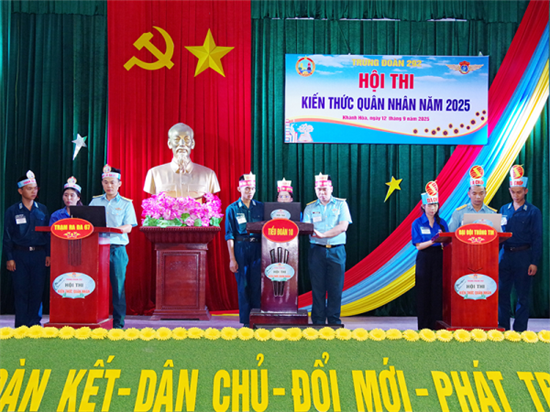Amid the developments of the 4th Industrial Revolution and the trend of comprehensive digitalisation with their profound impacts on all aspects of social life, as well as the requirement of building a revolutionary, regular, elite, modern Vietnam People's Army (VPA), the building of "digital soldiers" has become an important, urgent task. However, to achieve this goal, many issues need to be taken into account to research, discuss, and propose synchronised and feasible solutions.
Currently, although there is no official concept of "digital soldiers", it can be understood in practice that they are soldiers of the VPA with strong political will, pure revolutionary ethics, great professional expertise, modern technological knowledge and skills, being proficient in digital tools and platforms, knowing how to exploit, process, and apply data and artificial intelligence (AI) in leadership, command, management, training, combat readiness, information security, and military confidentiality. This new force is capable of quickly, creatively adapting to and effectively handling situations in the digital environment and the building of a modern VPA, thus making a direct contribution to improving our VPA’s overall quality and combat strength.
 |
| Illustrative photo (baoquankhu2.com.vn) |
Fully aware of the importance of digital transformation, over the years, the Central Military Commission (CMC) and the Ministry of National Defence (MND) have exercised their resolute, synchronised, uniform leadership and direction over digital transformation, achieving good progress and quality, laying a solid foundation for the building of a contingent of "digital soldiers". The MND Steering Committee for Administrative Reform and Digital Transformation has issued Project on "digital transformation within the MND towards 2025, with a vision towards 2030", with specific, appropriate goals, content, and road map. In the process, awareness and a sense of responsibility among party committees and commands at all levels have been raised; digital transformation has been incorporated in resolutions and regular work plans and seriously carried out. Digital infrastructures, integrated platforms, military data transmission networks, and digitalisation of personal signatures have been gradually realised in a uniform, synchronous, safe manner. In particular, many models of digital transformation in training, logistics, technical support, finance, and social insurance have initially proved to be effective and contributed to raising the VPA’s synergy and combat strength.
Those above-mentioned achievements not only improve the condition and environment for applying modern technology in the VPA, but also create necessary resources to form and develop a pool of "digital soldiers" to meet the task requirements in the new situation. However, several issues have emerged from the process of building a corps of "digital soldiers", requiring further researches, discussions, and measures.
Firstly, regarding awareness and responsibility of party committees and commands. Currently, some party committees and commands have yet to fully understand the key role of digital transformation and the building of "digital soldiers"; their leadership and implementation process have yet to be synchronised; there is a lack of long-term solutions, especially in the training, development, planning, and use of "digital soldiers". To tackle this issue, all-level party committees and commands and each officer and soldier should be fully aware that digital transformation and the development of "digital soldiers" represent an inevitable trend, acting as a deciding factor in the VPA's combat readiness in a hi-tech warfare. Emphasis should be placed on grasping and strictly executing resolutions, directives, and conclusions by the Party Central Committee, CMC, and MND, especially the CMC’s Resolution 3488-NQ/QUTW, dated 29 January 2025 on breakthroughs in science - technology development, innovation, and digital transformation in the VPA.
The issuance of specialised resolutions on digital transformation and the building of "digital soldiers", with specific action plans, close inspection and supervision at all levels, must be prioritised to ensure quality and efficiency. Also, the results of this work should be closely linked with the accountability of party committees and commands. Simultaneously, it is important to well conduct political education and ideological orientation to achieve unity in will and action among troops. By 2026, all cadres and soldiers shall have a full awareness of digital transformation and great digital knowledge and skills and know how to use digital platforms and services in their duties, operate smart devices to exploit information, utilise essential digital platforms and services, as well as protect themselves in the digital environment.
Second, in terms of military security in the digital environment. The digitalisation of information, data, training processes, combat plans, and organisational structure within military units poses a risk of disclosure of confidential and top-secret information. Therefore, agencies of the MND should continue to maintain coordination in researching and developing secure digital platforms and internal networks for the VPA only. These systems must not only meet the highest standards of cybersecurity, but also ensure user-friendliness and integration with other infrastructures. At the same time, it is essential to supplement and complete statutory regulations on information security and conduct of soldiers on digital platforms and social networks. Units must strictly control the use of smart devices, strengthen monitoring of internal networks, and prevent and combat malware and spyware. In addition, each soldier needs to be equipped with digital skills and other skills to protect personal information and military secrets. All soldiers must strictly comply with regulations on information safety, promptly detect and resolutely fight the illegal sharing of information or creation of loopholes for hostile forces’ exploitation through popular digital applications.
Thirdly, with reference to technological infrastructures in support of digital transformation. The existing technological infrastructures, software, and equipment for digital transformation in many units are still insufficient or not synchronised. Some pieces of internal software are simple, having poor connectivity, affecting the building of "digital soldiers". Therefore, the MND should focus its investment on building digital infrastructures that meet military standards, developing modern science - technology infrastructures associated with appropriate equipment usage plans. Due attention should be paid to developing military cloud computing networks, backup data centres, and big data processing systems across the whole VPA. Businesses and research institutes under the MND should develop digital software and applications, especially for training simulation and virtual exercises to improve education and training and reduce costs. At the same time, appropriate social resources should be mobilised in accordance with statutory regulations. It is necessary to promote cooperation and proactively learn from the experiences of offices and units both inside and outside the VPA in science, technology, innovation, and digital transformation, while consideration should be given to linking infrastructural investment with human resource training to ensure that all soldiers have a chance to access modern technology in the digital age.
 |
| “Digital soldier” section during a contest held at Regiment 292, Air Defence Division 377 (photo: phongkhongkhongquan.vn) |
Fourthly, concerning resources for the development of “digital soldiers”. Despite the fact that digital transformation in the VPA has reaped initial remarkable achievements, there have been differences in digital capability and skills among groups of troops. Some commanders have limited digital capability; digital transformation has yet to be closely linked with units’ missions. To handle this problem, it is vital that offices and units grasp and realise “Framework for basic digital skills and knowledge and Guidelines for evaluation and recognition of digital skills in the VPA” according to Decision 3039/QĐ-BQP, dated 25 June 2025, by the MND. Offices and units should define their roadmap and resolve under the spirit of “clear tasks, clear responsibility, clear outcomes, clear timelines, and feasibility”. Heads of offices and units should set a typical example in directing, managing and handling digital documents. In addition, military schools and academies should update their cadets on digital knowledge and skills; units should practically implement “Digital Literacy Campaign” to equip troops with basic digital skills and knowledge, while providing intensive training for their core force in hi-tech sector, cyber warfare, and military technology. Offices and units should hold digital refresher courses and workshops, organise more competitions on innovation and solutions for applying new technologies, and execute models and movements aimed at improving digital skills among their troops. Simultaneously, each soldier should heighten self-awareness and passion for studying and mastering digital skills and technologies.
Fifthly, in regard to mechanisms and policies. Currently, mechanisms and policies for the building of a pool of “digital soldiers” remain inconsistent; incentive mechanisms are limited; coordination between research centres and technology businesses is still poor. Thus, functional agencies should maintain coordination in reviewing, supplementing, and perfecting mechanisms and policies to settle obstacles, accelerate digital transformation, and promote digital literacy among all troops. It is essential to establish unified regulations on managing, training, and using “digital soldiers” in the entire VPA, with digital standards appropriate to each position and mission. In addition, there should be incentive mechanisms, such as training, appointment, and rewards for soldiers having brilliant digital initiatives; favourable conditions should be created for technology research and application in training, study, and work. It is essential to perfect mechanisms for coordination between the VPA and civilian businesses, research institutes, and training facilities to enable the Military to quickly obtain technological advances and ensure military secrets, information security, and digital sovereignty. It is necessary to form a "digital soldier" profile management system across the entire VPA for personnel planning and rotation based on digital competencies. Mechanisms and policies to ensure a positive learning and working environment and assist soldiers in the digital transformation process should be also formulated. Due attention should be paid to enhancing inspection and review work to make timely adjustments, ensure feasibility and sustainability, and contribute to the formation of a corps of "digital soldiers" in the whole VPA.
The development of a contingent of “digital soldiers” is a long-term strategic task, requiring breakthrough mindset, synchronised approaches, and flexible measures. This is not a temporary trend, but a fundamental requirement for our VPA to maintain its pivotal role in protecting the Fatherland in the digital age. In this article, several solutions, particularly on unified awareness, human development, perfection of mechanisms, and model shaping are proposed for party committees, commands, offices, and units across the Military to consider and adopt.
Only when its soldiers master digital space can the VPA master operations in the digital environment. This transformation is vital to achieving the strategic goal of building a revolutionary, regular, elite, modern VPA capable of safeguarding the Fatherland in any circumstances.
Sr. Col. NGUYEN DO PHU, PhD
Political Officer College